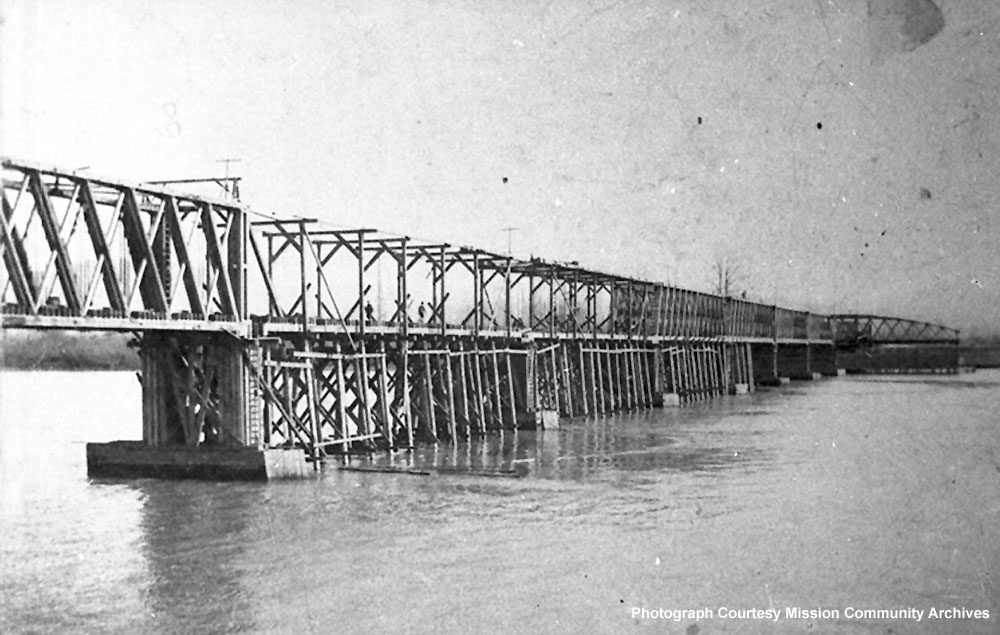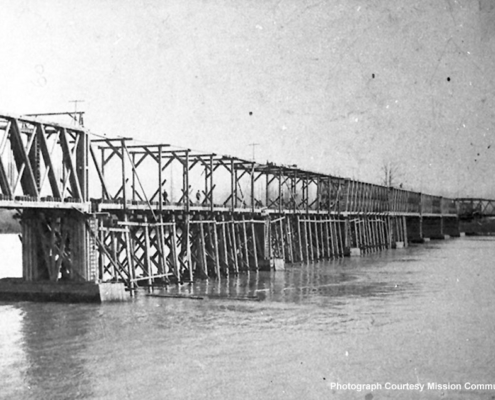Canadian Pacific Railway Train Bridge
Location:
Harbour Street
Historic Neighbourhood:
Flats
Date of Original Construction:
1891
Category:
Commercial/Industrial
Status:
Canadian Pacific Railway
Description:
The CPR bridge spans the Fraser River; connecting the rail lines from the USA through Matsqui in the south to Mission in the north. The bridge is currently made of steel and is about 1700 feet long. At the point of the river that it sits on, the water is twenty to forty feet deep and travels between 3 and 4 miles per hour during freshets. The bridge is only used to carry rail traffic currently and has a 10 kilometer per hour speed restriction.
History:
Originally built using wood, the structure was completed on February 14, 1891. This bridge would be the only western railway link to America at the time it was built and was only the second bridge to span the Fraser River. The bridge was originally built on wooden pilings and remained the lowest downstream bridge for the first thirteen years. In 1903, the swing span was converted to steel. This change was followed by all spans being converted to steel in 1908 and 1910 and also all piers being converted to concrete in 1908 and 1909 (with the first being #9 in 1904).
The swing span in the middle of the bridge was originally opened by a horse, named Charlie, who would walk around a capstan bar on the rail tracks at the center of the bridge. The swing span was used very often in the early days as commercial river track was the most common transportation and as a result, in 1903 it was converted to a steel lattice girder. In 1911, the use of a horse was withdrawn and a gas engine was installed in a shanty at the top of the lattice to open the swing through 90 degrees in sixty seconds. The swing was used a lot until the mid-1920s when use was dramatically decreased due to the last sternwheeler being withdrawn from the river.
For the first thirty-six years, the bridge was used only for rail traffic while a ferry took vehicle traffic from one side of the river to the other. Local citizens frequently lobbied for the bridge to be opened, and in 1927 the bridge was planked for vehicle traffic with one lane controlled by a traffic light with access from both sides. The planking was done by decking the bridge with wood; making for a fifteen-foot wide pavement section. Between the years 1927 and 1973, the British Columbian government paid a rental fee to the Canadian Pacific Railway to ensure that vehicle and pedestrian traffic could cross.
Many local citizens still recall crossing the bridge in buggies, cars, and trucks. It could be a scary experience if a train came along, as recalled by Rhona Jacobsen, who used to push a baby carriage across from Matsqui to do her shopping.
When the bridge was damaged in 1955 on July 24, as pier #11 immediately south of the swing span collapsed sending truss span #8 into the river, the ferry was once again used for vehicle traffic. The bridge was repaired over the next year by placing a concrete mat on the upstream river bottom to prevent river scour and pier #11 being rebuilt with a new 220-ton truss.
It was then officially re-opened on August 13, 1956, for both rail and vehicular traffic once again. The bridge continued to be used in this way until July 7, 1973, when the modern Mission Bridge (west of the CPR bridge) was opened for vehicle traffic and the planking was removed from the CPR bridge.
People Associated with the Site:
Sam Smith, worked on CPR construction crews since 1884 and was one of the work crew who helped construct the bridge from 1889-91. He settled in Dewdney, where he farmed, and later bought Hori Windebank’s waterworks that he ran from 1929 onwards.
Both Jack Krimmer and Scotty Willock worked as bridge tenders, while Pete Gustafson served as the roadmaster. John Danielson was the CPR’s section foreman.
Myrna Locken and Jim Sproule were on the bridge when it collapsed in 1955.
Architectural Features:
Currently, the bridge is built of steel and includes a steel lattice girder in the center swing span. It is about 1700 feet long and includes 12 concrete piers which support eight 160 foot thru-truss spans, one swing span of 230 feet and three girder spans which are beside the banks. It currently only has one railway track running down the center and is used only for rail traffic.
Timeline of repairs and improvements:
1891 – Constructed in wood as the only western link to America
1903 – Swing span converted to steel lattice girder
1908-09 – All piers converted to concrete
1908-10 – All spans converted to steel
1911 – Gas engine installed at the top of the lattice to open the swing
1927 – Planked for vehicle traffic
Where to get further information:
The Mission Community Archives
“History of the River Industry in Mission”, Oral History. Lifetime Learning Society, February 21, 2007.
Morigeau, Maureen. Digital Oral History notes: “Voices from the Past”. HP Project, 2007.
Railways in Mission-Abbotsford Area, Fraser Valley, British Columbia: Past and Present. Pacific Coast Branch C.R.H.A., 1973, pg. 3-4.
PR 1-8A, Flood, 1894.
PR 4-4, CPR Bridge with horse, 1910.
PR 13-9, CPR Bridge, ca.1890
PR 56-21, CPR Bridge, 1955.
PR 66-18A, Flood, 1894.
PR 111-6, CPR Bridge Crew, 1909.
PR 143-19, CPR Bridge, 28 Apr 1927.
PR 149-14, CPR Bridge, ca.1912.
PR 173-25, CPR Bridge, 1890.
PR 173-32, Ferry (bridge in background), ca.1925.
PR 212-7, CPR Bridge, June 1948.
PR 243-33, CPR Bridge, 1955.
PR 243-34, CPR Bridge, July 1956.
PR 291-92A, CPR Bridge, Early 1920’s.





